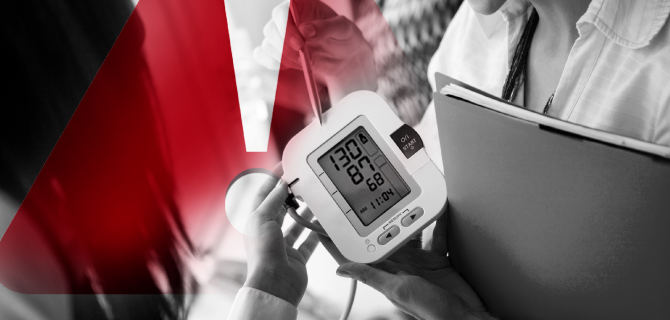Diastolic blood pressure (DBP) is a crucial component of cardiovascular health, yet it often receives less attention than systolic blood pressure (SBP). While many focus on the top number in a blood pressure reading, the bottom number—diastolic pressure—plays a significant role in assessing heart health. This article explores the danger zone of diastolic blood pressure, its implications, causes, and management strategies.
What Is Diastolic Blood Pressure?
Diastolic blood pressure measures the pressure in your arteries when your heart rests between beats. It is represented as the lower number in a blood pressure reading. For example, in a reading of 120/80 mm Hg, 80 mm Hg is the diastolic pressure.
Normal diastolic pressure is typically below 80 mm Hg.
The Importance of Monitoring Diastolic Blood Pressure
Monitoring both systolic and diastolic pressures is essential for understanding overall cardiovascular health. While systolic pressure indicates how hard your heart pumps blood, diastolic pressure reflects how well your arteries can relax and fill with blood. High diastolic pressure can indicate increased resistance in the arteries, which can lead to serious health complications.
SEE ALSO: How Much Can Sudafed Raise Blood Pressure?
Defining The Danger Zone
Diastolic blood pressure is classified into several categories based on its measurement:
Normal: Less than 80 mm Hg
Elevated: 80–89 mm Hg
Stage 1 Hypertension: 90–99 mm Hg
Stage 2 Hypertension: 100 mm Hg or higher
The danger zone for diastolic blood pressure begins at 80 mm Hg and increases significantly at 90 mm Hg and above. High diastolic readings can lead to various cardiovascular issues, including heart disease and stroke.
Health Risks Associated with High Diastolic Blood Pressure
High diastolic blood pressure can increase the risk of several health conditions:
Heart Disease: Elevated DBP can lead to increased workload on the heart, causing hypertrophy (thickening of the heart muscle) and eventually heart failure.
Stroke: A high diastolic reading can impair blood flow to the brain, increasing the risk of ischemic strokes.
Kidney Damage: Chronic high DBP can affect kidney function by damaging the small blood vessels within the kidneys.
Vision Loss: Increased pressure in the blood vessels can lead to damage to the retina, resulting in vision problems.
Causes of High Diastolic Blood Pressure
While the exact cause of high diastolic blood pressure remains unclear, several factors contribute to its elevation:
Obesity: Excess body weight increases strain on the heart and raises blood pressure.
Diet: High salt intake can increase fluid retention and raise blood pressure.
Smoking and Alcohol Use: Both substances can damage blood vessels and contribute to hypertension.
Genetics: A family history of hypertension increases your risk.
Isolated Diastolic Hypertension (IDH)
Isolated Diastolic Hypertension (IDH) occurs when only the diastolic number is elevated while systolic remains normal. IDH is less common but still poses risks. It has been observed more frequently in younger males and individuals with specific health conditions like diabetes.
The J-Curve Phenomenon
Recent studies have introduced a concept known as the “J-Curve” phenomenon concerning diastolic blood pressure. This theory suggests that both very high and very low diastolic pressures are associated with increased cardiovascular risk. For instance, a DBP below 60 mm Hg may also elevate risks for heart attacks and strokes, especially among older adults.
Symptoms of High Diastolic Blood Pressure
High diastolic blood pressure often does not present noticeable symptoms until it reaches dangerously high levels. Some potential symptoms include:
- Headaches
- Dizziness
- Shortness of breath
- Chest pain
It is essential to monitor your blood pressure regularly, even if you do not experience these symptoms.
Management Strategies for High Diastolic Blood Pressure
Managing high diastolic blood pressure often involves lifestyle changes and medical interventions:
Lifestyle Changes
Dietary Modifications:
Adopt a heart-healthy diet rich in fruits, vegetables, whole grains, lean proteins, and low-fat dairy.
Reduce sodium intake to help lower blood pressure.
Regular Exercise:
Aim for at least 150 minutes of moderate aerobic activity each week.
Incorporate strength training exercises at least two days per week.
Weight Management:
Achieve and maintain a healthy weight through diet and exercise.
Limit Alcohol Consumption:
Drink alcohol in moderation—up to one drink per day for women and two for men.
Quit Smoking:
Seek support to quit smoking as it significantly impacts cardiovascular health.
Medical Treatments
If lifestyle changes are insufficient, healthcare providers may prescribe medications to help control high diastolic blood pressure:
Calcium Channel Blockers: Help relax blood vessels.
ACE Inhibitors: Lower BP by preventing hormone production that narrows blood vessels.
Diuretics: Help eliminate excess sodium and water from the body.
Conclusion
Understanding the danger zone of diastolic blood pressure is vital for maintaining cardiovascular health. While systolic numbers often dominate discussions about hypertension, elevated diastolic readings pose significant risks that should not be overlooked. Regular monitoring, lifestyle changes, and appropriate medical interventions play essential roles in managing this condition effectively.
Related topics:


